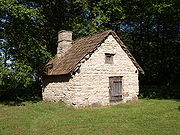
Estonian vernacular architecture
Encyclopedia

Vernacular architecture
Vernacular architecture is a term used to categorize methods of construction which use locally available resources and traditions to address local needs and circumstances. Vernacular architecture tends to evolve over time to reflect the environmental, cultural and historical context in which it...
styles throughout Estonia
Estonia
Estonia , officially the Republic of Estonia , is a state in the Baltic region of Northern Europe. It is bordered to the north by the Gulf of Finland, to the west by the Baltic Sea, to the south by Latvia , and to the east by Lake Peipsi and the Russian Federation . Across the Baltic Sea lies...
, embodied in villages, farmyards and farm houses. The oldest written sources describing Estonian villages date back to the 13th century when they were mentioned in the Liber Census Daniae and by the chronicler Henry of Livonia
Villages and farmyards
Village styles varied according to geographical regions each having its own characteristic features. In the flat plains of northern Estonia and SaaremaaSaaremaa
Saaremaa is the largest island in Estonia, measuring 2,673 km². The main island of Saare County, it is located in the Baltic Sea, south of Hiiumaa island, and belongs to the West Estonian Archipelago...
are seen the oldest forms of village where farms are assembled in compact clusters, with denser clusters found to the north west. In hilly country of southern Estonia a more dispersed type of village was found. In the east, on the coast of Lake Peipus
Lake Peipus
Lake Peipus, ) is the biggest transboundary lake in Europe on the border between Estonia and Russia.The lake is the fifth largest in Europe after Lake Ladoga and Lake Onega in Russia north of St...
and the eastern part of Setumaa, the classical street type village was predominant, while row type villages can be found all over the country.
Farm buildings

Black Bread
Black Bread is a 2010 Catalan-language Catalan drama film written and directed by Agustí Villaronga. The screenplay is based on the homonymous novel by Emili Teixidor, with elements of two other works by him, Retrat d'un assassí d'ocells and Sic transit Gloria Swanson.The film won nine Goya...
and an agrarian tradition dating back some 4000 years, with the threshing barn and dwelling housed under the same roof, thatched with reeds or rye
Rye
Rye is a grass grown extensively as a grain and as a forage crop. It is a member of the wheat tribe and is closely related to barley and wheat. Rye grain is used for flour, rye bread, rye beer, some whiskeys, some vodkas, and animal fodder...
straw.
The form of a traditional 19th century farmhouse is a long chimney-less building with low walls of horizontal logs and a high straw thatched roof. The log walls are one third and the roof two thirds of the total building height. The build has three sections, the threshing floor, the kiln room and the dwelling chamber and was used as the primary residence during the winter. The kiln room was the only heated room and all indoor activities were carried out there. During the autumn it was used to dry grain. From summer to autumn cooking was performed in an external summer kitchen and people slept in hay lofts and store rooms.

